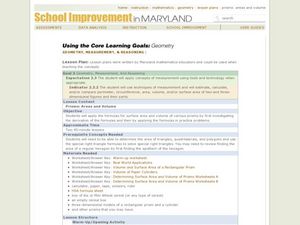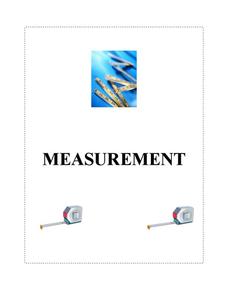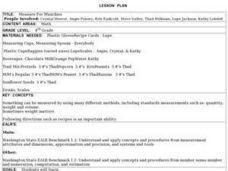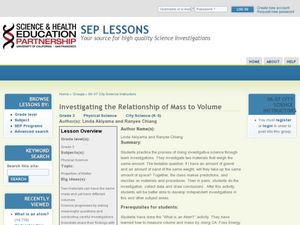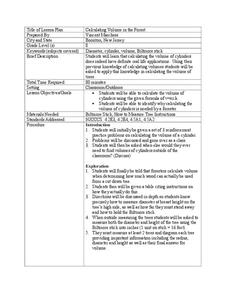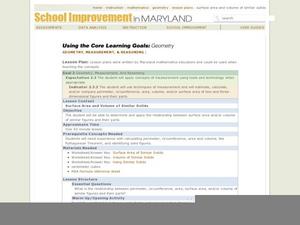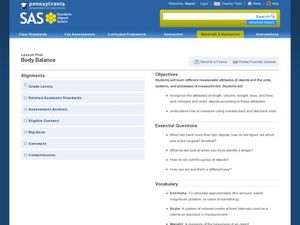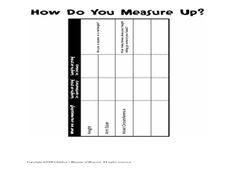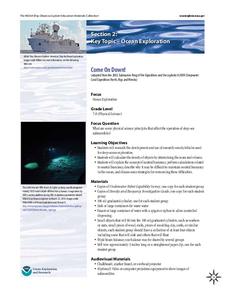Curated OER
Geometry, Measurement & Reasoning
Learners measure prisms and determine their volume. In this measurement and reasoning lesson, students estimate the volume and area of prisms. They measure given boxes. Learners use paper to create prisms and cylinders. They determine...
Curated OER
Measurement
Students identify and categorize different problem situations or contexts using one of four measurements to solve the problem. Through guided and independent practice, they discover ways to determine which measurement to use when...
Curated OER
Volume
In this volume worksheet, students participate in an experiment to test the volume in a few food containers. Students complete an experiment and then answer six comprehension questions regarding the results of their experiment.
Curated OER
Measurement - What is it?
Students work in groups to make accurate measurements. For this area and perimeter measurement lesson, the student groups determine what they will measure and what tools they will need, then find the accurate measurement or area,...
Curated OER
Measurement
Students explore the necessity for standards of measurement and measure length, volume, mass and angles. In this measurement lesson plan, students use their hand and foot to measure objects in the room. They compare their measurements to...
Curated OER
Measure for Munchies
Fourth graders are introduced to the various types of measurements. Using a recipe, they practice measuring out the correct amount of ingredients while making the food. They also practice using a scale and following the directions on a...
Curated OER
Investigating the Relationship of Mass to Volume
Third graders explore the relationship of mass to volume. In this physical science lesson, 3rd graders participate in an investigation with a several materials and measure the mass and volume using scientific tools. Students discuss and...
Curated OER
Makeshift Measuring Tools
Fifth graders practice measuring items with unique tools. In this length lesson, 5th graders examine several household items and must decide if they want to use a pencil width, piece of paper, or their thumb to measure the item....
Curated OER
Calculating Volume in the Forest
Eighth graders use their knowledge of calculating the volume of cylinders to calculate the volume of trees. For this volume lesson plan, 8th graders identify why calculating the volume of cylinders would be valuable to a forester.
Curated OER
Surface Area and Volume of Similar Solids
Students explore similar figures. In this surface area and volume lesson, students identify the relationship between the surface area and volume of similar figures.
Curated OER
Linking Length, Perimeter, Area, and Volume
Students explore measurements of rectangles. In this measurement comparison lesson, students discover the length, width, perimeter, and area of two different rectangles. Students record their measurements on a chart to make comparisons.
Curated OER
Body Balance
Examine measurable characteristics of objects to build an understanding of the different ways you can discuss an object's size when comparing it to other objects. After whole group instruction, the class compares and organizes several...
Curated OER
Formulas for Volume and Surface Area
Students calculate the volume and surface area of each shape. In this geometry lesson, students use nets and other three dimensional polygons to create visuals of the volume of a shape. They define important vocabulary words...
Curated OER
Surface Area and Volume of a Cylinder
Seventh graders find the surface area and volume of a cylinder. In this area and volume lesson, 7th graders complete several activities to learn the volume and surface area of cylinders.
Curated OER
Area and Volume Metric Conversions - Grade Seven
Middle schoolers investigate unit conversion. In this unit conversion lesson, students will build models of square and cubic centimeters using grid paper and generate formula tables for converting units of area and volume. ...
Nuffield Foundation
Measuring Respiratory Quotient
How do scientists prove tiny living things respire? Young scientists build a respirometer and measure respiration rates in living creatures. By comparing the measurements of both plants and animals, they understand the similarities.
Mathematics Assessment Project
Estimating Volume: The Money Munchers
Don't stuff money under your mattress. To find out why learners first complete a task determining how $24,000 in cash would affect the height of a mattress and whether this same amount would fit into a suitcase of given dimensions....
Curated OER
How Do You Measure Up?
Students measure their body. In this measurement lesson plan, students use a string to measure their height and the circumference of their head. They record this information on the worksheet provided and answer questions as a group.
Cornell University
Buoyancy
Swimmers know to float by turning their bodies horizontally rather than vertically, but why does that make a difference? In an interesting lesson, scholars explore buoyancy and the properties of air and water. They test cups to see which...
American Chemical Society
What is Density?
Density: the reason a giant pumpkin will float, but a tiny cranberry won't. Lesson begins with a demonstration of two of the same-sized cubes having different densities. Then pupils take eight cubes, each of the same size, and have to...
Virginia Department of Education
Charles’ Law
Searching for a relatively interesting way to demonstrate Charles' Law? Here is a lesson in which pupils heat air inside a flask and then cool the flask to quickly cool the air. They make observations about what occurs during the...
NOAA
Come on Down!
What do we do when a dive is too dangerous for humans to accomplish? Send in the robots! Middle school scientists get acquainted with several different models of submersible robots in the second lesson of six from NOAA. Lab groups then...
EngageNY
Modeling with Polynomials—An Introduction (part 1)
Maximizing resources is essential to productivity. Class members complete an activity to show how math can help in the process. Using a piece of construction paper, learners construct a box with the maximum volume. Ultimately, they...
Curated OER
We All Scream for Ice Scream
High schoolers explore the formulas for volume of three-dimensional objects. They participate in various activities involving ice cream, ice cream cones, small candies, and gum balls, recording their calculations on a lab sheet.
